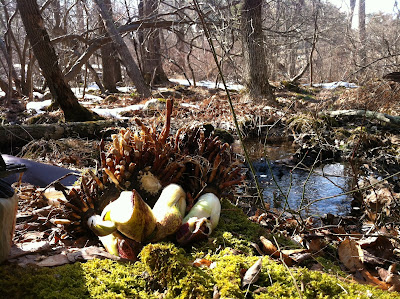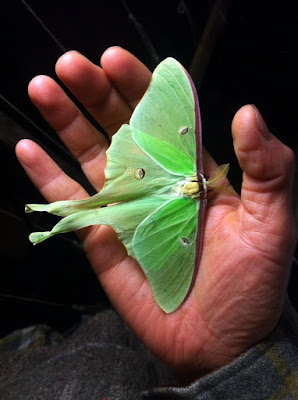In one of my classics classes this quarter, we covered 1-2 chapters each week on a selected chapter of the Yellow Emperor's Classic of Medicine (黃帝内經素問). Our final essay involved briefly summating the experience, via discussing the ideal of harmony between Heaven, Humanity, and Earth. With thirteen classes to wrap up this quarter and limited time, I could only spend one afternoon on this essay. I would still like to share it with you. In future essays, I would like to explore more on energetics, share some school-related stories, and gossip more about the Suwen. But first, Earth, Human, and Sky. Enjoy!
~
天地人
The Microcosm- Macrocosm Correspondence between Earth- Human- Sky
Standing in Universe stance, I root my feet firmly into the Earth thru Kd-1 (湧泉), while anchoring the top of my head to the Sky via GV-20 (百會). I feel the smoothness of my breath, the stability of my bones, the supple strength of my muscles, the alignment of my spine as a lightning rod connecting me with the Universe, via Earth and Sky, electricity in the form of breath, blood and Qi coursing through my being. Blessed with this human body and life to be powerfully walking between, supported by, and supporting both Sky and Earth, I take on my life responsibilities with humanity, humility, dignity, reverence, and gratitude.
The first few chapters of the Neìjīng Sùwen (黃帝内經素問) address this Heaven-Human-Earth connection (天地人), or the microcosm-macrocosm correspondence. In this paper, I examine a few passages that explore this relationship, and how it connects with me as a human, student, and future practitioner of this medicine.
[Heaven and earth] can be father and mother of the myriad beings.
The clear yang rises towards heaven; the turbid yin returns to the earth.
(from Suwen 5, Unschuld translation)
In the Yì Jīng (易經/ Book of Changes), Sky (or Heaven) is represented by three solid lines. Earth is represented by three broken lines. Hexagram 11, or Taì (泰), shows the Sky under the Earth. Earth, representing the epitome of yin energy, wants to move downwards. Sky, representing the height of yang energy, wants to move upwards. In this arrangement, they move towards each other, in constant communication. Taì does not represent a static peace, but demonstrates instead a dynamic equilibrium between yin and yang that culminates in a peace that allows both to move as they need, each in accordance with the other, while solid within their personal power, in a state of constant transformation. Hexagram 12 on the other hand, or Pĭ (否), shows the Earth under the Sky. This seems logically correct, right? However, yin moves downwards, while yang moves upwards. In this arrangement, they keep moving away from each other, incommunicado, distant. The person thus falls apart. Illness is simply a lack of communication, stuck qi, imbalance between yin and yang, or an imbalance of our internal Earth and Sky.
If one follows yin and yang, then life results; if one opposes them, then death results.
If one follows them, then order results; if one opposes them, then disorder results.
(from Suwen 2, Unschuld translation)
In Chinese medicine’s view of life, nature revolves around the interplay between yin and yang. The ongoing courtship dance between the two constitutes health or disease. To have more of one or another would create imbalance, leading to illness. To “follow” them means to follow the flow of the energy, responding accordingly to what’s necessary in the moment to continue flowing organically. Alignment between Heaven, Humanity, and Earth means to exist with yin and yang dancing harmoniously, adjusting for seasonal and other changes with dietary, lifestyle, medicinal, and other seasonally appropriate modifications.
When a disease persists over a long time, it is transmitted [in the organism] and transformed. When [a stage is reached where] above and below have lost their union, then [even] a good physician cannot do anything about it. Hence, the sages arranged yin and yang [in such a way that their] sinews and vessels were in harmony, [their] bones and marrow were solid and firm, and [their] qi and blood both followed [their usual course]. In such a situation, inner and outer are balanced in harmony…
(from Suwen 3, Unschuld translation)
One of the strengths of Chinese medicine, particularly herbal medicine, is its ability to address each unique individual, and tonify them in tailored ways that match what they truly need. This fortifies the inner reserves, making that person more resilient against unwanted xié qì (邪氣), or pathogens. By creating a solid nourished core that roots into the Earth and connects with the Sky, a person is more steady in their center, and less likely to waver due to unwanted external or internal influences. As practitioners, we cultivate inner Taì (泰) via good food, sleep, exercise, and a fulfilling life. By nourishing and strengthening ourselves, we can approach our patients with honesty and self-knowing, fully understanding both sickness and how to recover from it, with a diversity of practices and protocols tailored to each individual that we encounter.
… if the ruler is enlightened, his subjects are in peace.
To nourish one’s life on the basis of this results in longevity.
If the ruler is not enlightened, then the twelve officials are in danger.
(from Suwen 8, Unschuld translation)
The ruler is the Heart, who is the emperor of all of the other organ systems, or twelve officials. If the Heart Emperor is in balance, then all is well in the inner kingdom of the person. If the Heart Emperor is out of balance, then this is reflected in chaos in the kingdom. Harmony here refers to the twelve officials, or different body systems, working together to create a dynamic, efficient, effective, and elegant kingdom within the person. The Heart, governing the Spirit, dynamically connects the axis between Earth and Sky, terrestrial and celestial, human and Universe, microcosm and macrocosm. We cannot just address the physical. We must also address emotional, spiritual, and environmental wellness within ourselves, and our patients and communities. When meeting a patient for the first time, we first notice their shén (神), or our immediate impression of their general energy, almost like an “aura” that they exude. Addressing the patient as a whole human being is thus addressing the person on a shén (神) level. My self cultivation practices seek to nourish myself on a shén (神) level as well, which connects me not only with the deeper layers of myself, but also with the deeper layers of nature, and the Universe itself.
The accomplished [people] … of pure virtue and… entirely in accord with the Way…
adapted themselves to [the regularity] of yin and yang and lived in harmony with the four seasons.
(from Suwen 1, Unschuld translation)
One who is truly healthy and vibrant aligns with the natural rhythms of the Universe, yin and yang’s courtship dance, reflected in the fluctuating tides of our bodies that respond to the celestial cycles, seasonal cycles, and simply growing older day by day. We can engage in self-cultivation/ nourishing life (養身) practices to restore jīng (精/ Essence) and nourish shén (神/ Spirit).
Heaven has the essence; Earth has the physical appearance.
(from Suwen 5, Unschuld translation)
Earth, or yin, forms the solid container for Sky, or yang. In cultivating health on all levels, we caretake both our Earthen physical bodies, as well our Heavenly yang Spirits. How can we be effective conduits of energy to lead the most fulfilling lives, possible? How can we best nourish ourselves, and in doing so, help restore others to health and dynamic equilibrium, as well? How does our relationship with our internal Universe, our inner ecology, connect with our relationship with our outer Universe, our outer ecology of human, animal, plant, and mineral communities?
Exhaling, I drop my hands downwards back to the Earth, then inhale them in a circle out and up to greet the Sky one more time for this practice, collecting Sky energy with my hands and exhaling it back down to connect with Earth, collecting the energy into my center by inhaling my feet together and hands to my belly, one on top of another atop my umbilicus (CV-8/ 神闕), the center of my Universe, eyes gently closing, with a smile.
~
References
Quotes from Huangdi Neijing Suwen translations by Paul Unschuld and Hermann Tessenow, from Volume 1 of their 2011 Annotated Translation of Huang Di's Inner Classic- Basic Questions







